Presentation on Neurobiology of Autism: Current Issues in Biology
VerifiedAdded on 2023/01/16
|17
|1565
|32
Presentation
AI Summary
This presentation provides an overview of the neurobiology of autism, also known as Autism Spectrum Disorder (ASD). It begins with background information on ASD, including its prevalence, genetic and environmental factors, and heterogeneity. The presentation then analyzes two research articles. Th...
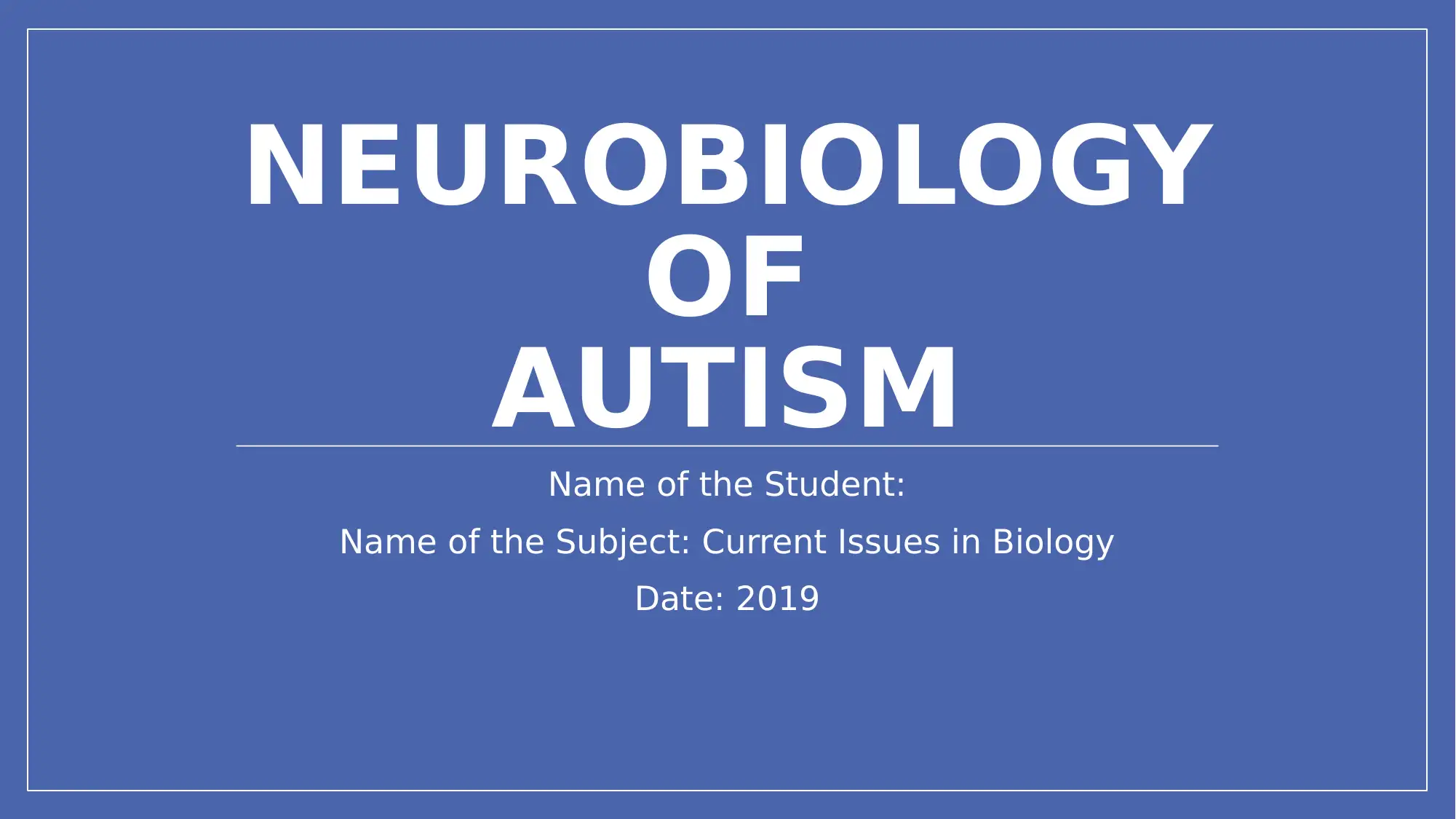
NEUROBIOLOGY
OF
AUTISM
Name of the Student:
Name of the Subject: Current Issues in Biology
Date: 2019
OF
AUTISM
Name of the Student:
Name of the Subject: Current Issues in Biology
Date: 2019
Paraphrase This Document
Need a fresh take? Get an instant paraphrase of this document with our AI Paraphraser
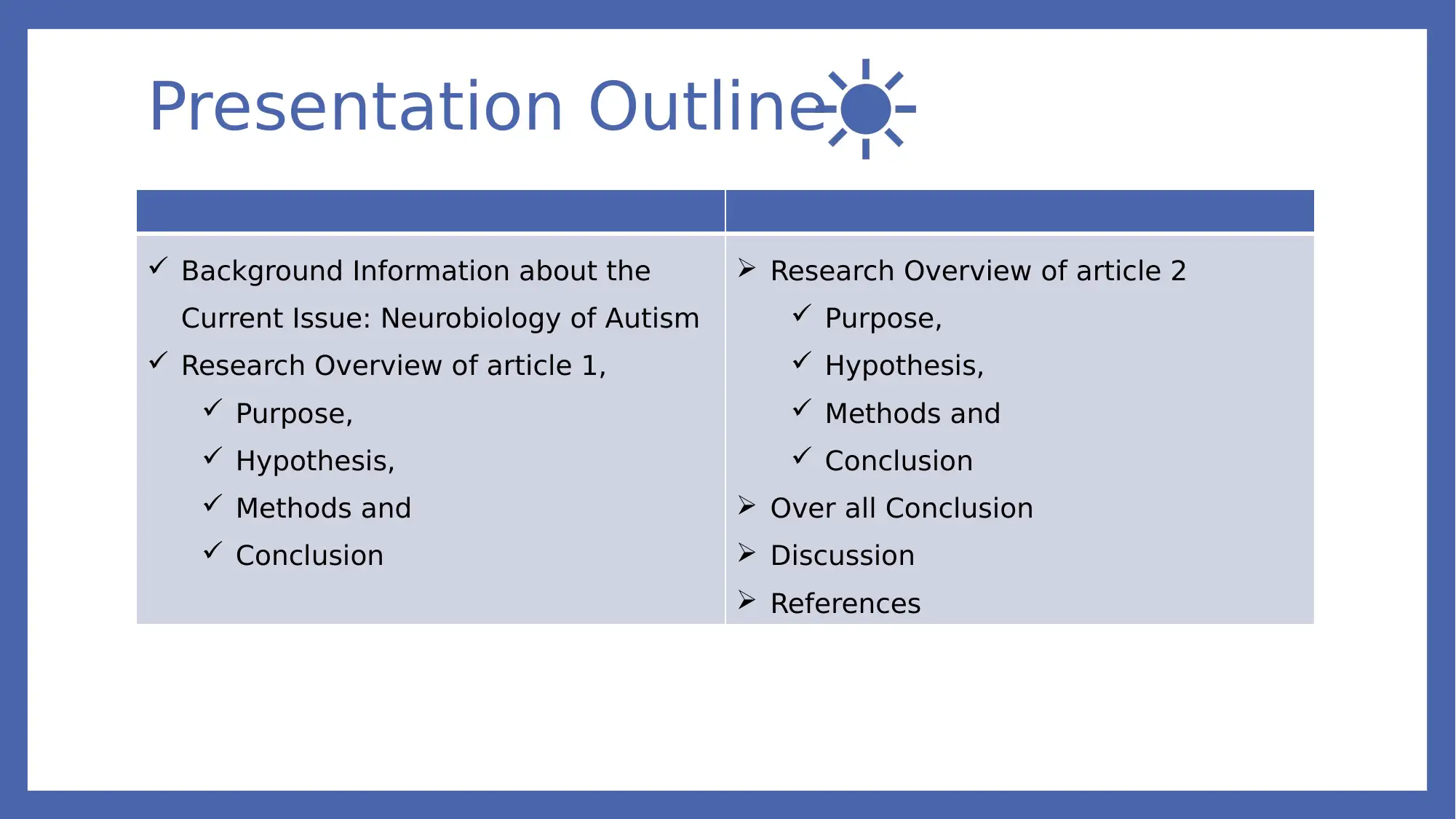
Presentation Outline
Background Information about the
Current Issue: Neurobiology of Autism
Research Overview of article 1,
Purpose,
Hypothesis,
Methods and
Conclusion
Research Overview of article 2
Purpose,
Hypothesis,
Methods and
Conclusion
Over all Conclusion
Discussion
References
Background Information about the
Current Issue: Neurobiology of Autism
Research Overview of article 1,
Purpose,
Hypothesis,
Methods and
Conclusion
Research Overview of article 2
Purpose,
Hypothesis,
Methods and
Conclusion
Over all Conclusion
Discussion
References
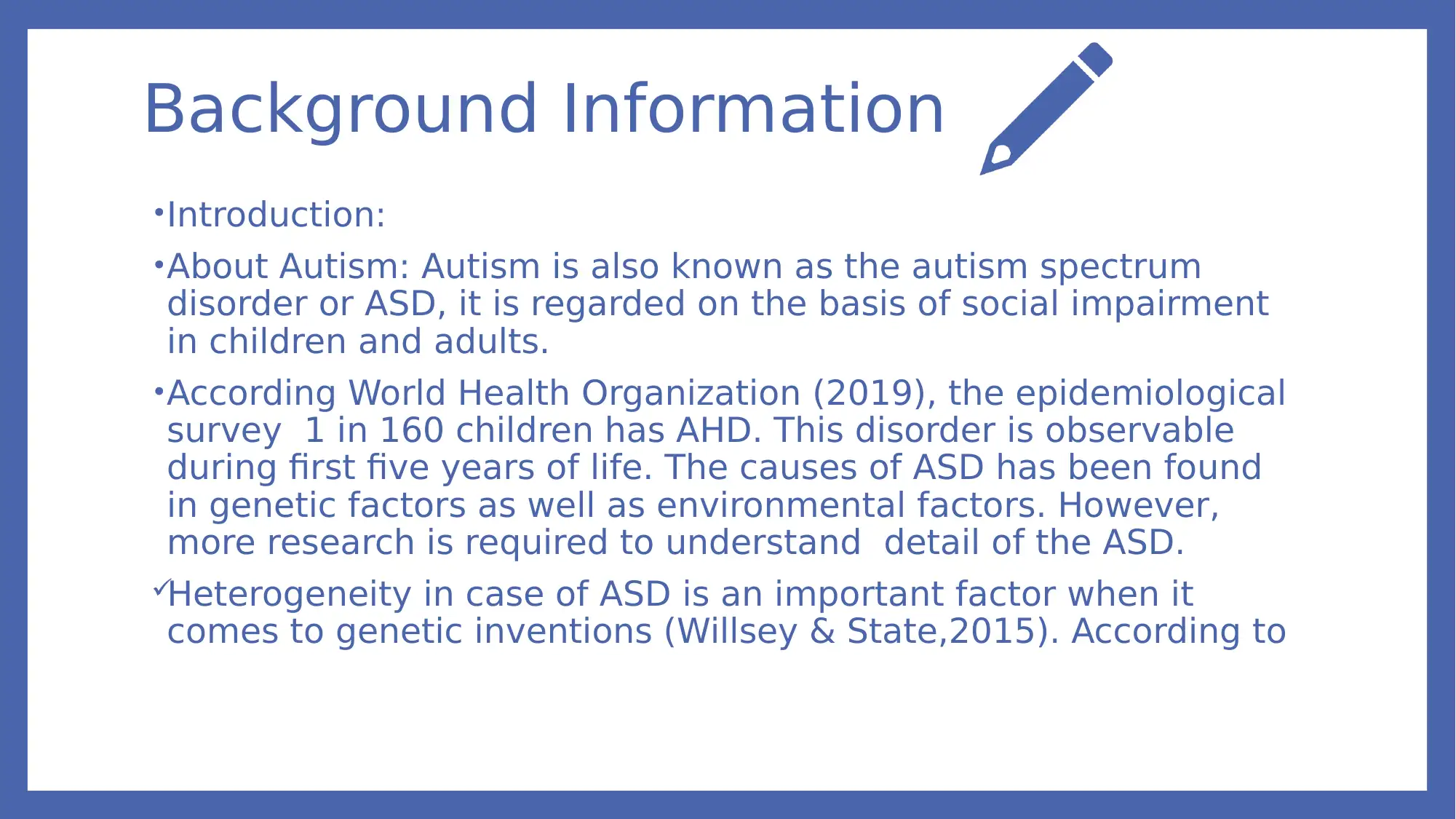
Background Information
•Introduction:
•About Autism: Autism is also known as the autism spectrum
disorder or ASD, it is regarded on the basis of social impairment
in children and adults.
•According World Health Organization (2019), the epidemiological
survey 1 in 160 children has AHD. This disorder is observable
during first five years of life. The causes of ASD has been found
in genetic factors as well as environmental factors. However,
more research is required to understand detail of the ASD.
Heterogeneity in case of ASD is an important factor when it
comes to genetic inventions (Willsey & State,2015). According to
•Introduction:
•About Autism: Autism is also known as the autism spectrum
disorder or ASD, it is regarded on the basis of social impairment
in children and adults.
•According World Health Organization (2019), the epidemiological
survey 1 in 160 children has AHD. This disorder is observable
during first five years of life. The causes of ASD has been found
in genetic factors as well as environmental factors. However,
more research is required to understand detail of the ASD.
Heterogeneity in case of ASD is an important factor when it
comes to genetic inventions (Willsey & State,2015). According to
You're viewing a preview
Unlock full access by subscribing today!
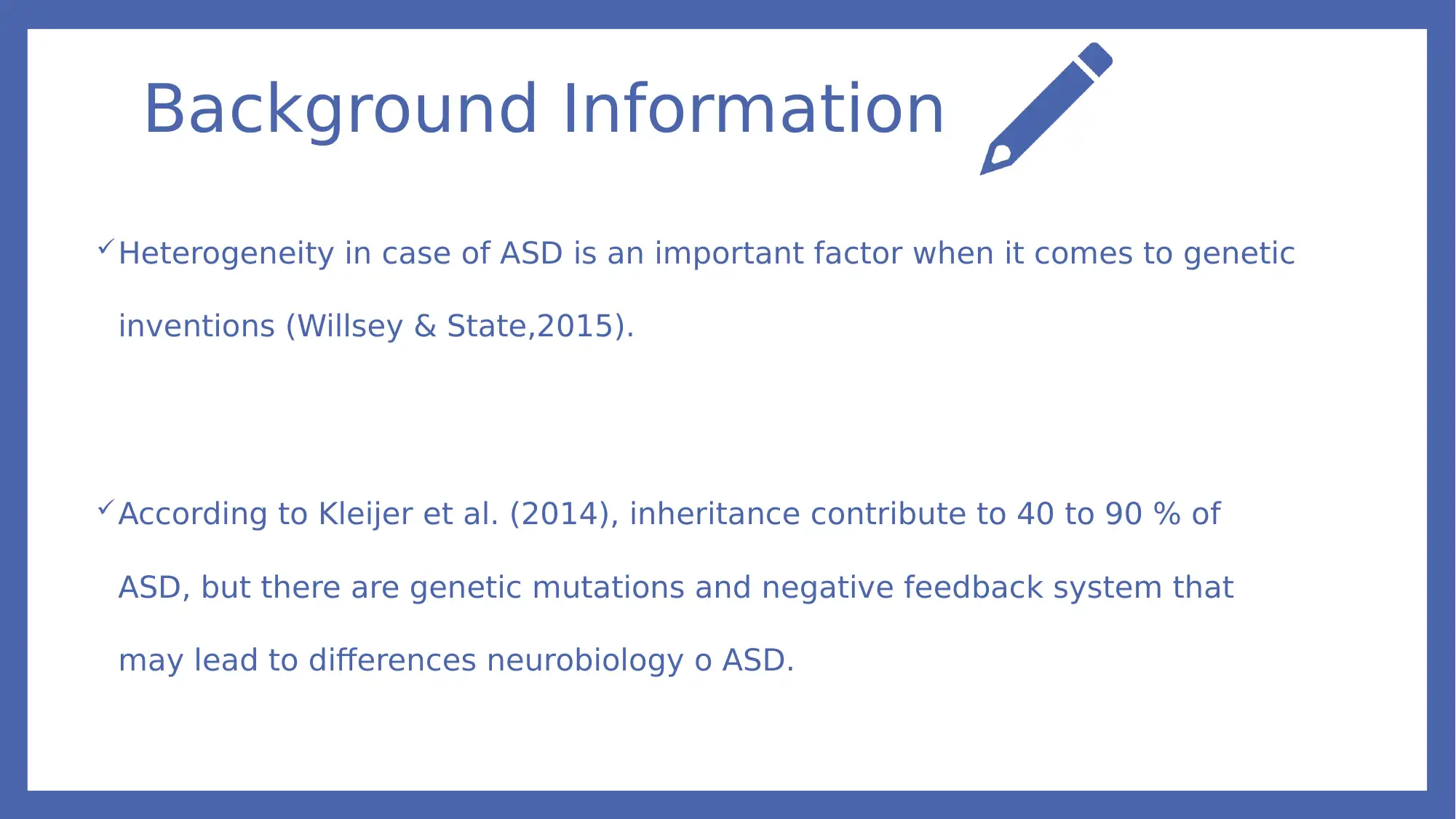
Background Information
Heterogeneity in case of ASD is an important factor when it comes to genetic
inventions (Willsey & State,2015).
According to Kleijer et al. (2014), inheritance contribute to 40 to 90 % of
ASD, but there are genetic mutations and negative feedback system that
may lead to differences neurobiology o ASD.
Heterogeneity in case of ASD is an important factor when it comes to genetic
inventions (Willsey & State,2015).
According to Kleijer et al. (2014), inheritance contribute to 40 to 90 % of
ASD, but there are genetic mutations and negative feedback system that
may lead to differences neurobiology o ASD.
Paraphrase This Document
Need a fresh take? Get an instant paraphrase of this document with our AI Paraphraser
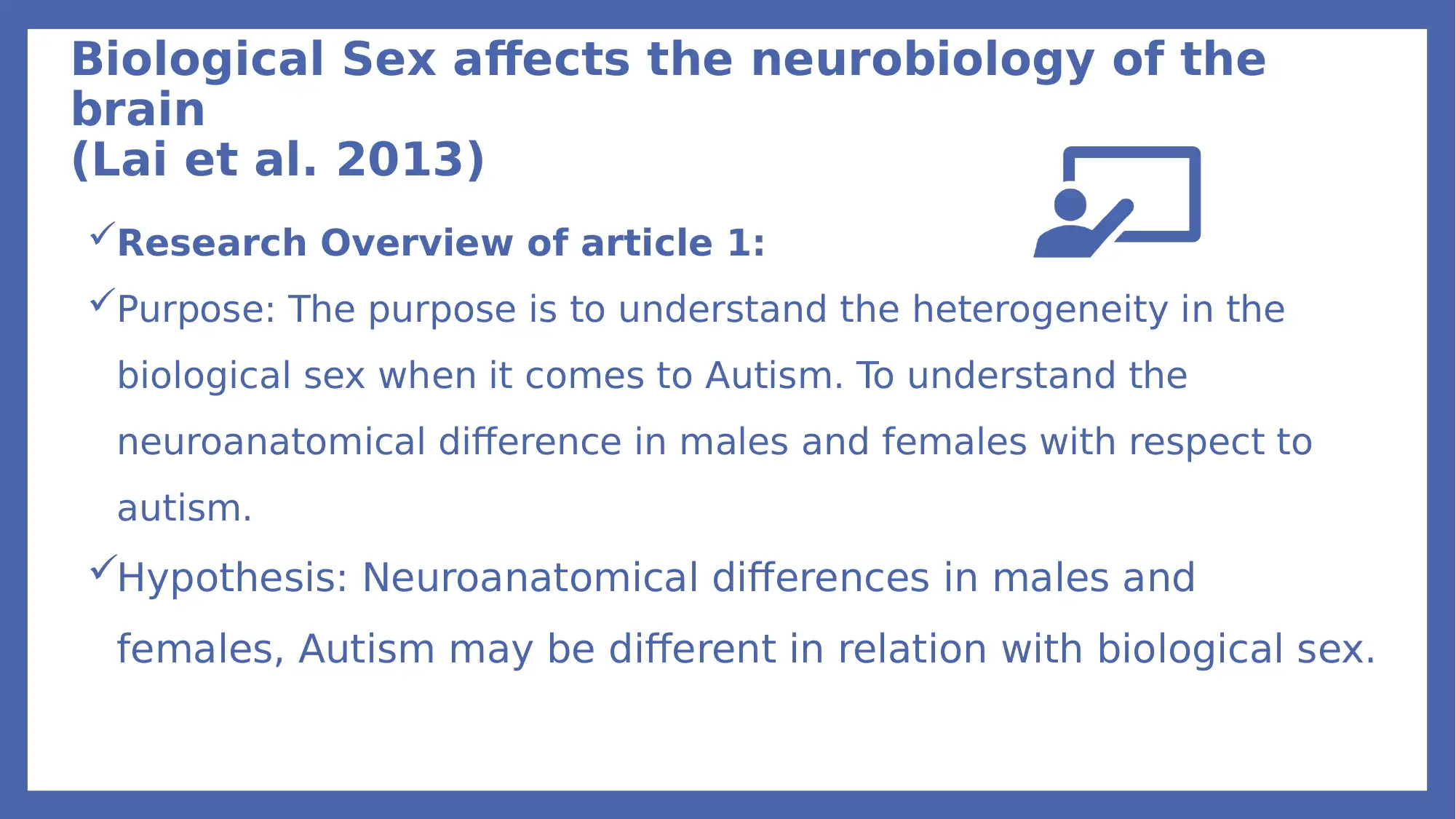
Biological Sex affects the neurobiology of the
brain
(Lai et al. 2013)
Research Overview of article 1:
Purpose: The purpose is to understand the heterogeneity in the
biological sex when it comes to Autism. To understand the
neuroanatomical difference in males and females with respect to
autism.
Hypothesis: Neuroanatomical differences in males and
females, Autism may be different in relation with biological sex.
brain
(Lai et al. 2013)
Research Overview of article 1:
Purpose: The purpose is to understand the heterogeneity in the
biological sex when it comes to Autism. To understand the
neuroanatomical difference in males and females with respect to
autism.
Hypothesis: Neuroanatomical differences in males and
females, Autism may be different in relation with biological sex.
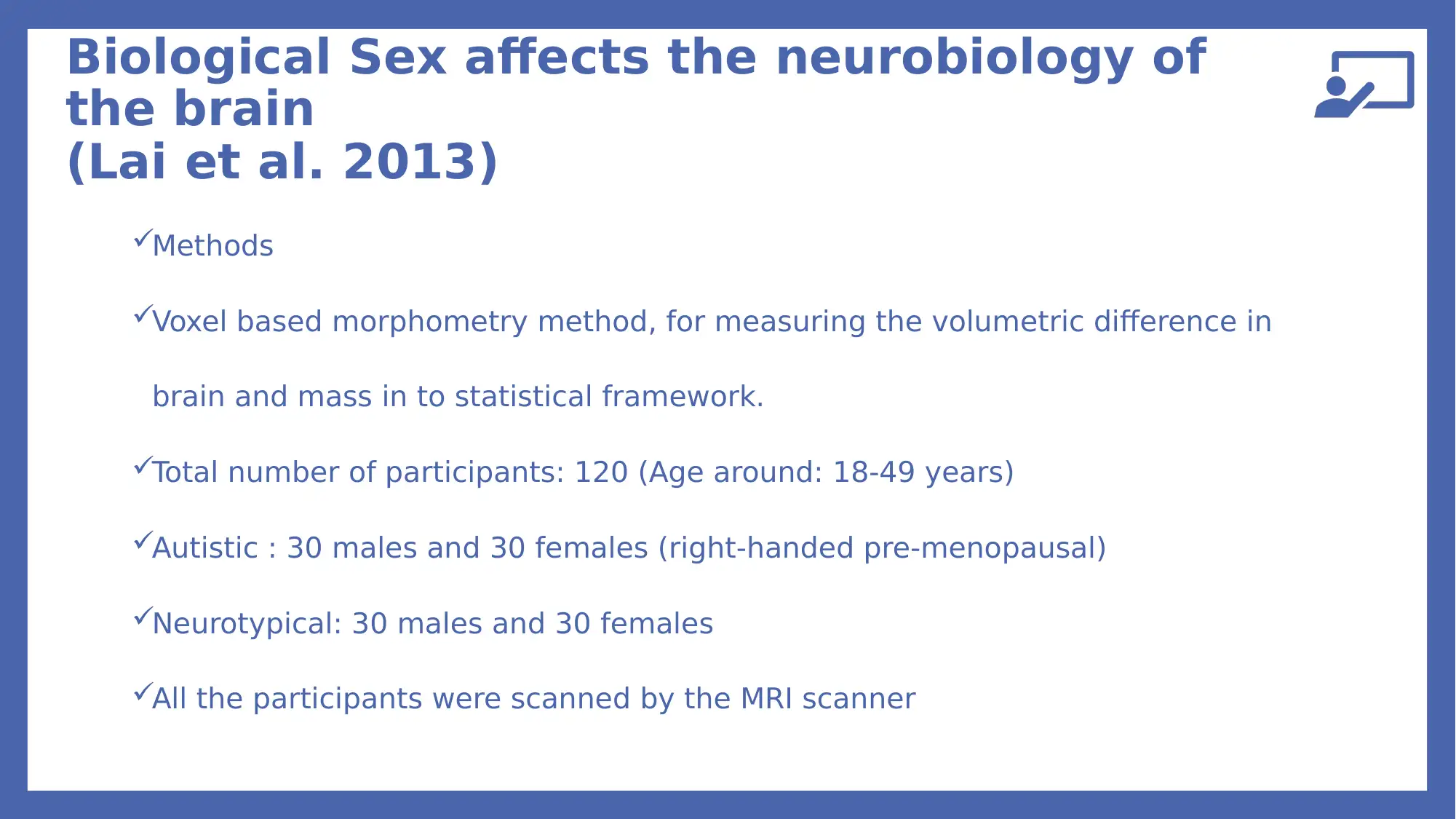
Biological Sex affects the neurobiology of
the brain
(Lai et al. 2013)
Methods
Voxel based morphometry method, for measuring the volumetric difference in
brain and mass in to statistical framework.
Total number of participants: 120 (Age around: 18-49 years)
Autistic : 30 males and 30 females (right-handed pre-menopausal)
Neurotypical: 30 males and 30 females
All the participants were scanned by the MRI scanner
the brain
(Lai et al. 2013)
Methods
Voxel based morphometry method, for measuring the volumetric difference in
brain and mass in to statistical framework.
Total number of participants: 120 (Age around: 18-49 years)
Autistic : 30 males and 30 females (right-handed pre-menopausal)
Neurotypical: 30 males and 30 females
All the participants were scanned by the MRI scanner
You're viewing a preview
Unlock full access by subscribing today!
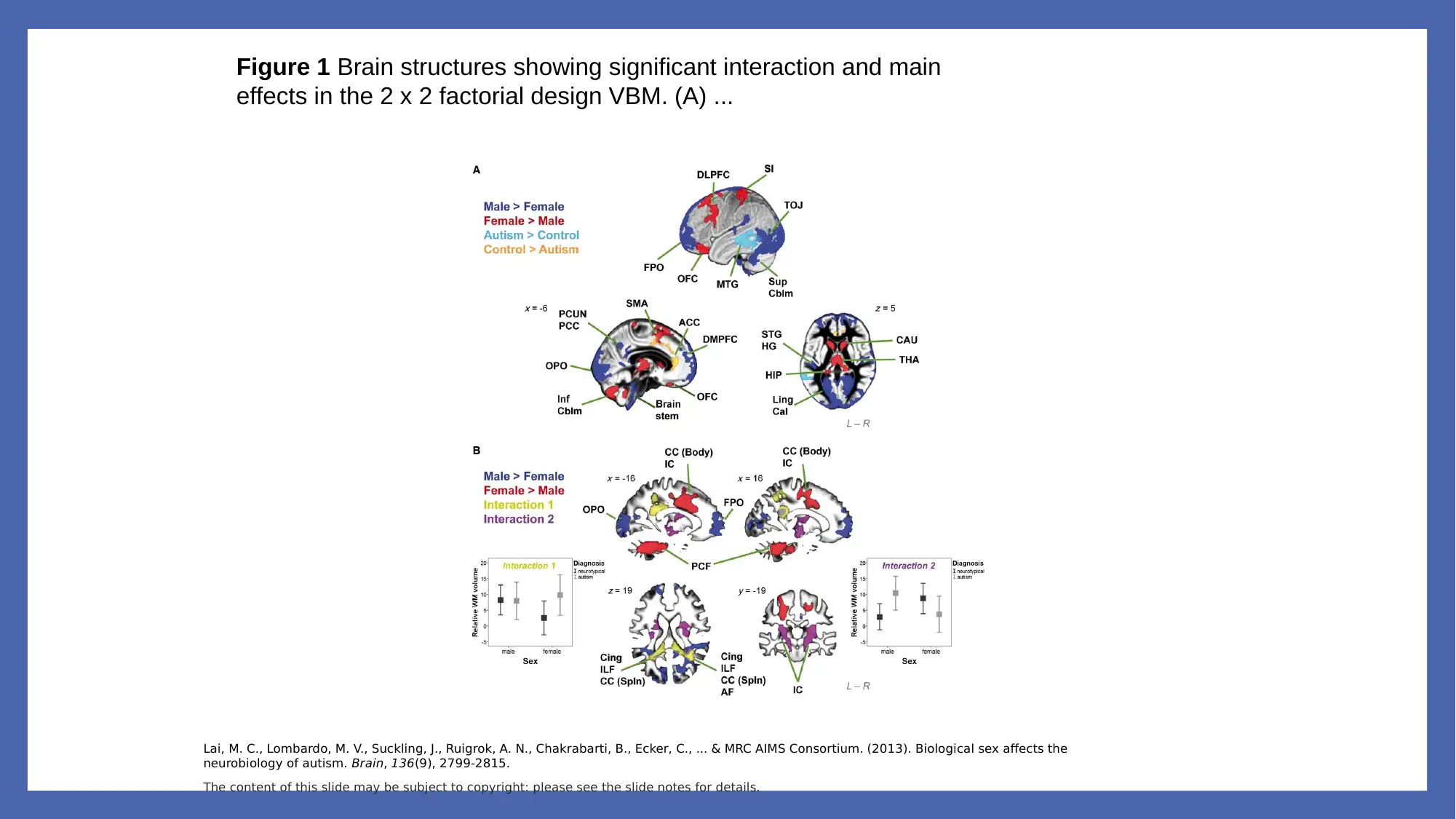
Lai, M. C., Lombardo, M. V., Suckling, J., Ruigrok, A. N., Chakrabarti, B., Ecker, C., ... & MRC AIMS Consortium. (2013). Biological sex affects the
neurobiology of autism. Brain, 136(9), 2799-2815.
The content of this slide may be subject to copyright: please see the slide notes for details.
Figure 1 Brain structures showing significant interaction and main
effects in the 2 x 2 factorial design VBM. (A) ...
neurobiology of autism. Brain, 136(9), 2799-2815.
The content of this slide may be subject to copyright: please see the slide notes for details.
Figure 1 Brain structures showing significant interaction and main
effects in the 2 x 2 factorial design VBM. (A) ...
Paraphrase This Document
Need a fresh take? Get an instant paraphrase of this document with our AI Paraphraser
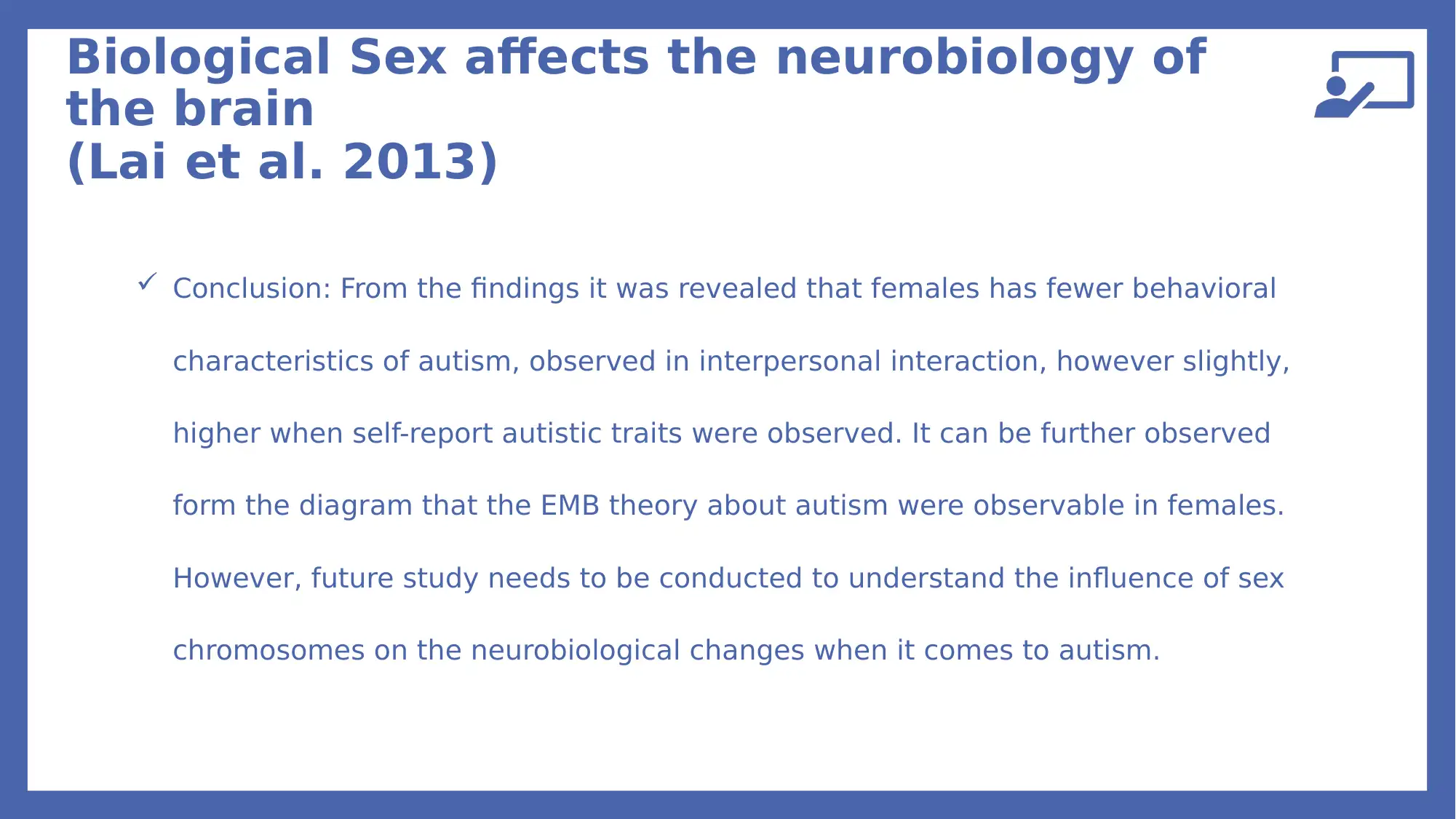
Biological Sex affects the neurobiology of
the brain
(Lai et al. 2013)
Conclusion: From the findings it was revealed that females has fewer behavioral
characteristics of autism, observed in interpersonal interaction, however slightly,
higher when self-report autistic traits were observed. It can be further observed
form the diagram that the EMB theory about autism were observable in females.
However, future study needs to be conducted to understand the influence of sex
chromosomes on the neurobiological changes when it comes to autism.
the brain
(Lai et al. 2013)
Conclusion: From the findings it was revealed that females has fewer behavioral
characteristics of autism, observed in interpersonal interaction, however slightly,
higher when self-report autistic traits were observed. It can be further observed
form the diagram that the EMB theory about autism were observable in females.
However, future study needs to be conducted to understand the influence of sex
chromosomes on the neurobiological changes when it comes to autism.
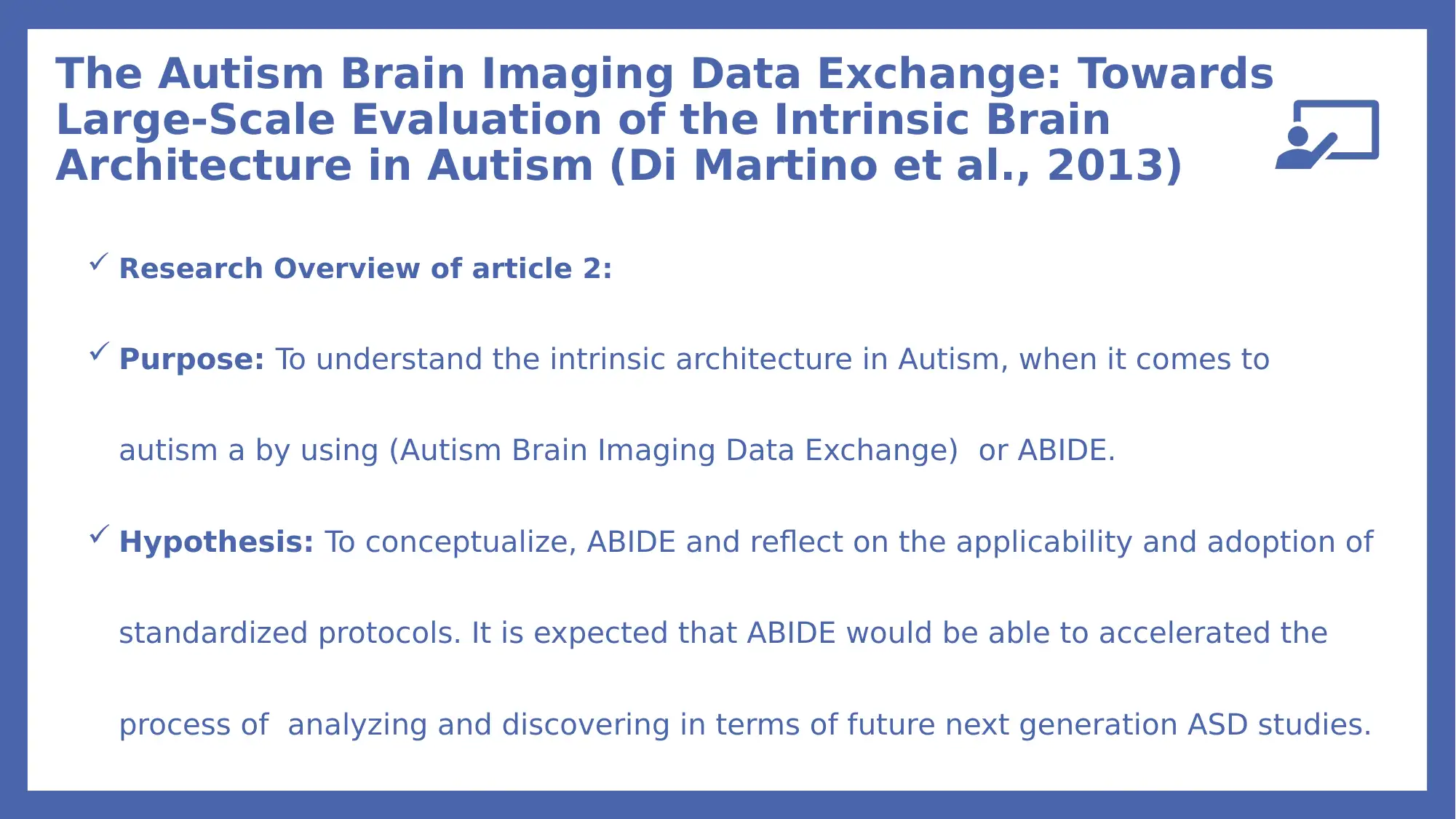
The Autism Brain Imaging Data Exchange: Towards
Large-Scale Evaluation of the Intrinsic Brain
Architecture in Autism (Di Martino et al., 2013)
Research Overview of article 2:
Purpose: To understand the intrinsic architecture in Autism, when it comes to
autism a by using (Autism Brain Imaging Data Exchange) or ABIDE.
Hypothesis: To conceptualize, ABIDE and reflect on the applicability and adoption of
standardized protocols. It is expected that ABIDE would be able to accelerated the
process of analyzing and discovering in terms of future next generation ASD studies.
Large-Scale Evaluation of the Intrinsic Brain
Architecture in Autism (Di Martino et al., 2013)
Research Overview of article 2:
Purpose: To understand the intrinsic architecture in Autism, when it comes to
autism a by using (Autism Brain Imaging Data Exchange) or ABIDE.
Hypothesis: To conceptualize, ABIDE and reflect on the applicability and adoption of
standardized protocols. It is expected that ABIDE would be able to accelerated the
process of analyzing and discovering in terms of future next generation ASD studies.
You're viewing a preview
Unlock full access by subscribing today!
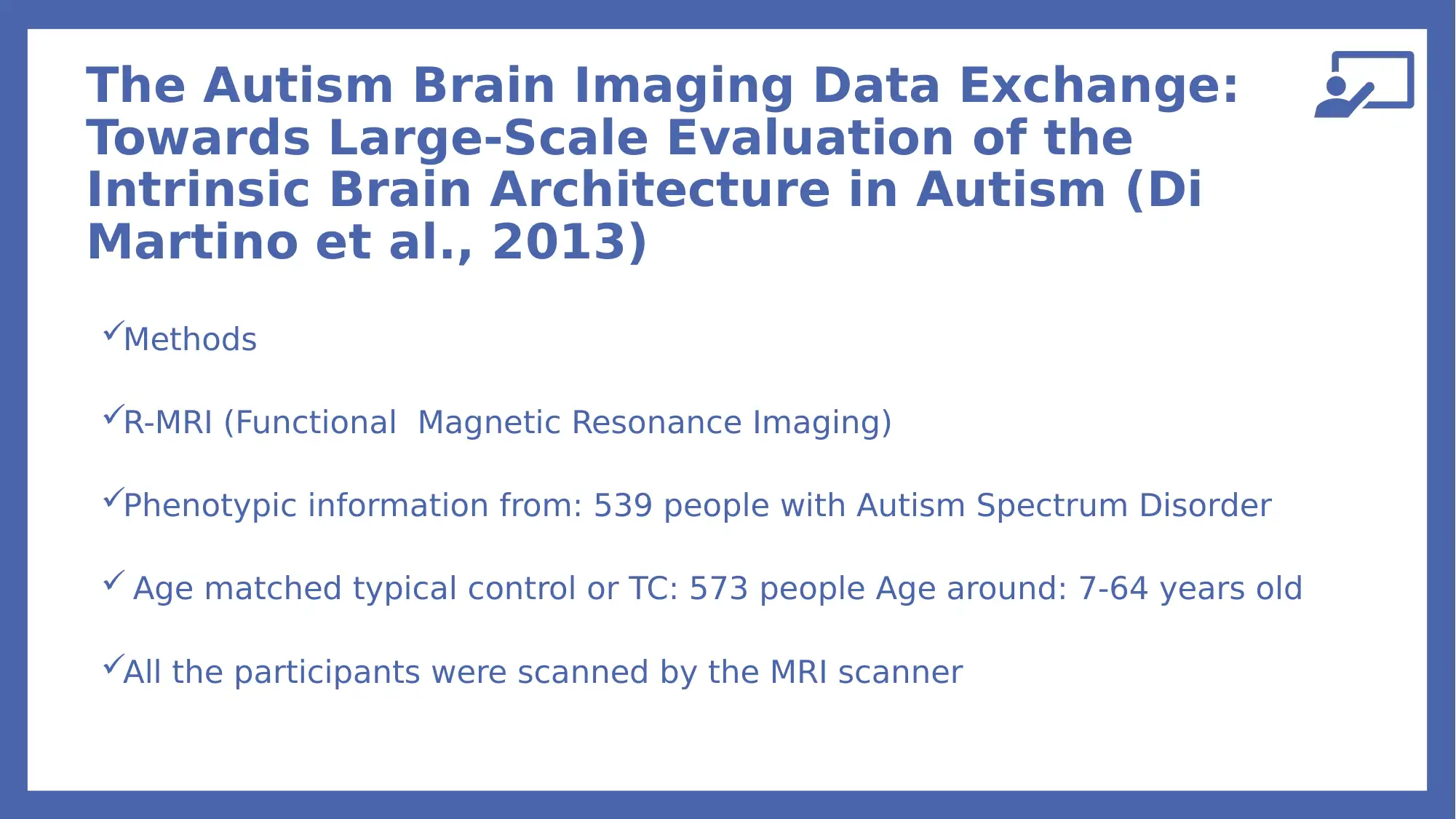
The Autism Brain Imaging Data Exchange:
Towards Large-Scale Evaluation of the
Intrinsic Brain Architecture in Autism (Di
Martino et al., 2013)
Methods
R-MRI (Functional Magnetic Resonance Imaging)
Phenotypic information from: 539 people with Autism Spectrum Disorder
Age matched typical control or TC: 573 people Age around: 7-64 years old
All the participants were scanned by the MRI scanner
Towards Large-Scale Evaluation of the
Intrinsic Brain Architecture in Autism (Di
Martino et al., 2013)
Methods
R-MRI (Functional Magnetic Resonance Imaging)
Phenotypic information from: 539 people with Autism Spectrum Disorder
Age matched typical control or TC: 573 people Age around: 7-64 years old
All the participants were scanned by the MRI scanner
Paraphrase This Document
Need a fresh take? Get an instant paraphrase of this document with our AI Paraphraser
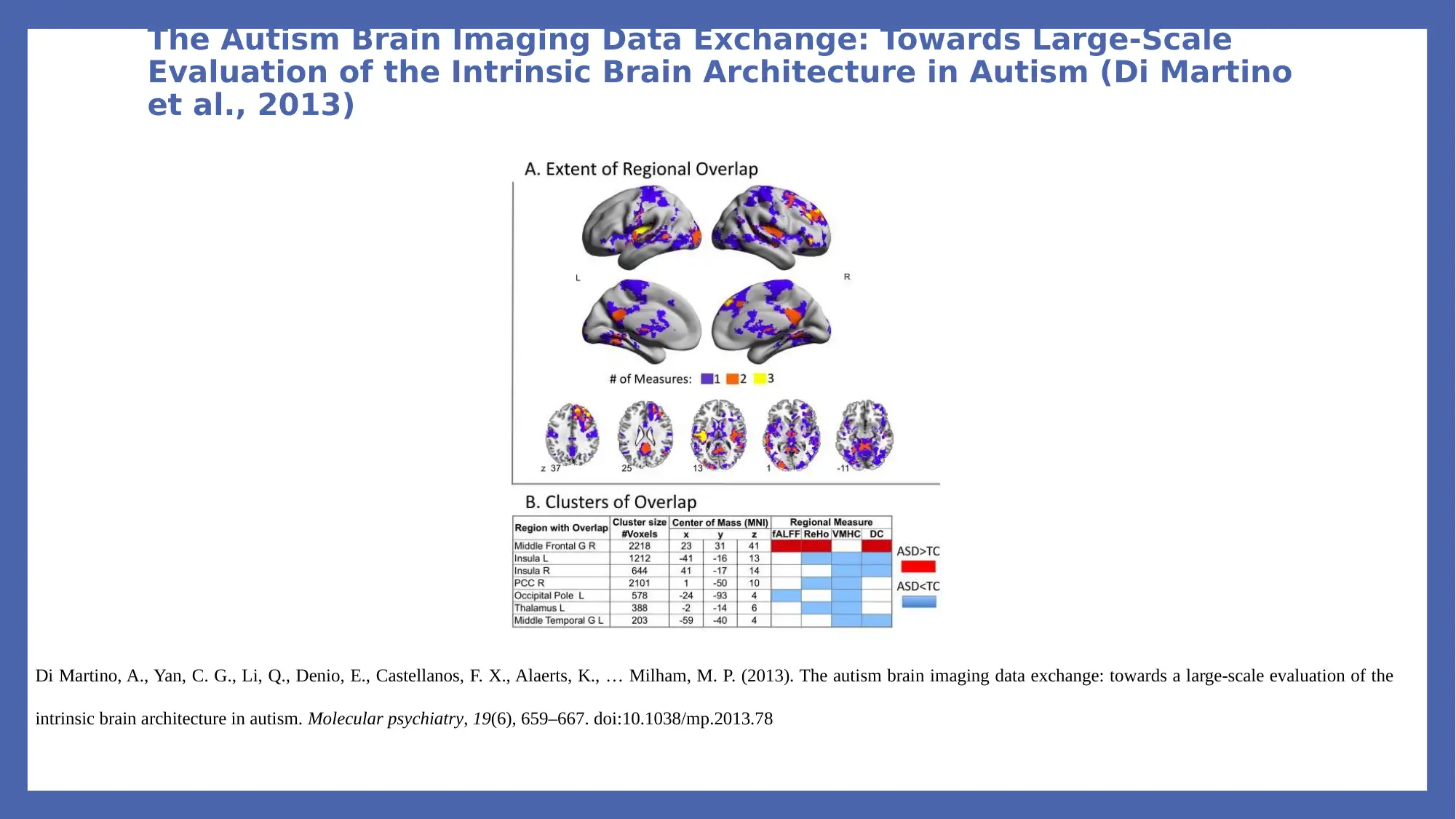
The Autism Brain Imaging Data Exchange: Towards Large-Scale
Evaluation of the Intrinsic Brain Architecture in Autism (Di Martino
et al., 2013)
Di Martino, A., Yan, C. G., Li, Q., Denio, E., Castellanos, F. X., Alaerts, K., … Milham, M. P. (2013). The autism brain imaging data exchange: towards a large-scale evaluation of the
intrinsic brain architecture in autism. Molecular psychiatry, 19(6), 659–667. doi:10.1038/mp.2013.78
Evaluation of the Intrinsic Brain Architecture in Autism (Di Martino
et al., 2013)
Di Martino, A., Yan, C. G., Li, Q., Denio, E., Castellanos, F. X., Alaerts, K., … Milham, M. P. (2013). The autism brain imaging data exchange: towards a large-scale evaluation of the
intrinsic brain architecture in autism. Molecular psychiatry, 19(6), 659–667. doi:10.1038/mp.2013.78
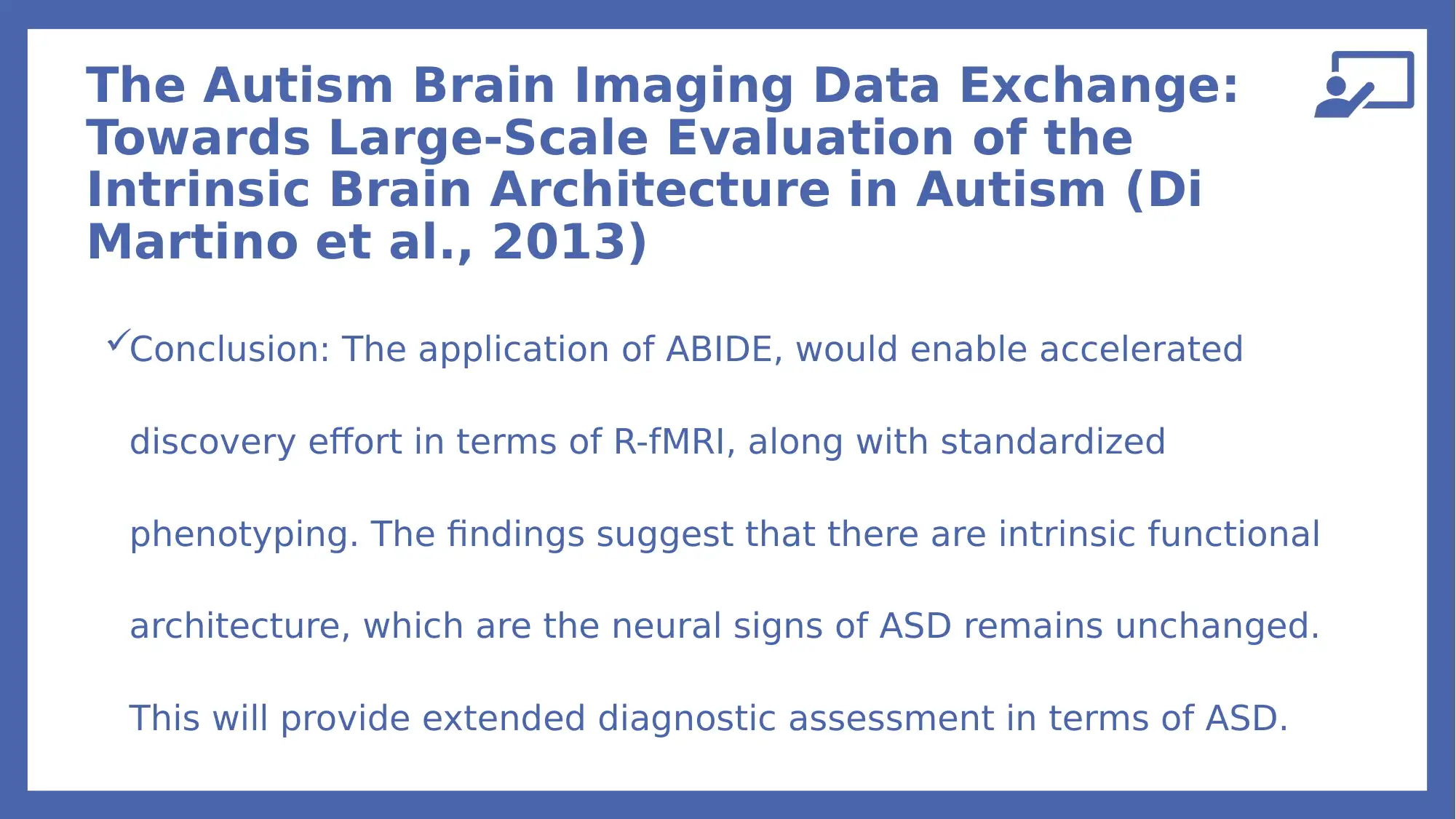
The Autism Brain Imaging Data Exchange:
Towards Large-Scale Evaluation of the
Intrinsic Brain Architecture in Autism (Di
Martino et al., 2013)
Conclusion: The application of ABIDE, would enable accelerated
discovery effort in terms of R-fMRI, along with standardized
phenotyping. The findings suggest that there are intrinsic functional
architecture, which are the neural signs of ASD remains unchanged.
This will provide extended diagnostic assessment in terms of ASD.
Towards Large-Scale Evaluation of the
Intrinsic Brain Architecture in Autism (Di
Martino et al., 2013)
Conclusion: The application of ABIDE, would enable accelerated
discovery effort in terms of R-fMRI, along with standardized
phenotyping. The findings suggest that there are intrinsic functional
architecture, which are the neural signs of ASD remains unchanged.
This will provide extended diagnostic assessment in terms of ASD.
You're viewing a preview
Unlock full access by subscribing today!
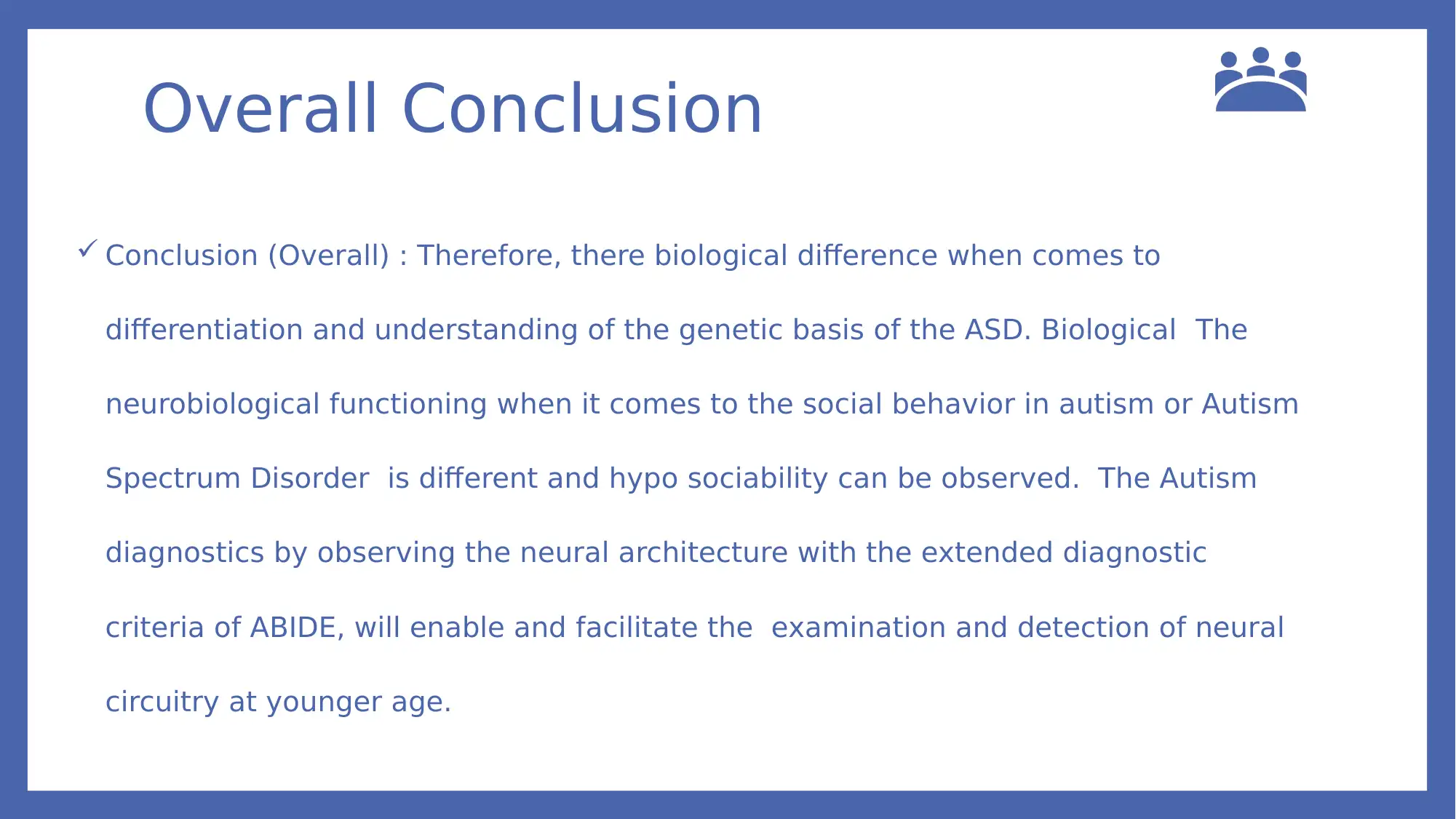
Overall Conclusion
Conclusion (Overall) : Therefore, there biological difference when comes to
differentiation and understanding of the genetic basis of the ASD. Biological The
neurobiological functioning when it comes to the social behavior in autism or Autism
Spectrum Disorder is different and hypo sociability can be observed. The Autism
diagnostics by observing the neural architecture with the extended diagnostic
criteria of ABIDE, will enable and facilitate the examination and detection of neural
circuitry at younger age.
Conclusion (Overall) : Therefore, there biological difference when comes to
differentiation and understanding of the genetic basis of the ASD. Biological The
neurobiological functioning when it comes to the social behavior in autism or Autism
Spectrum Disorder is different and hypo sociability can be observed. The Autism
diagnostics by observing the neural architecture with the extended diagnostic
criteria of ABIDE, will enable and facilitate the examination and detection of neural
circuitry at younger age.
Paraphrase This Document
Need a fresh take? Get an instant paraphrase of this document with our AI Paraphraser
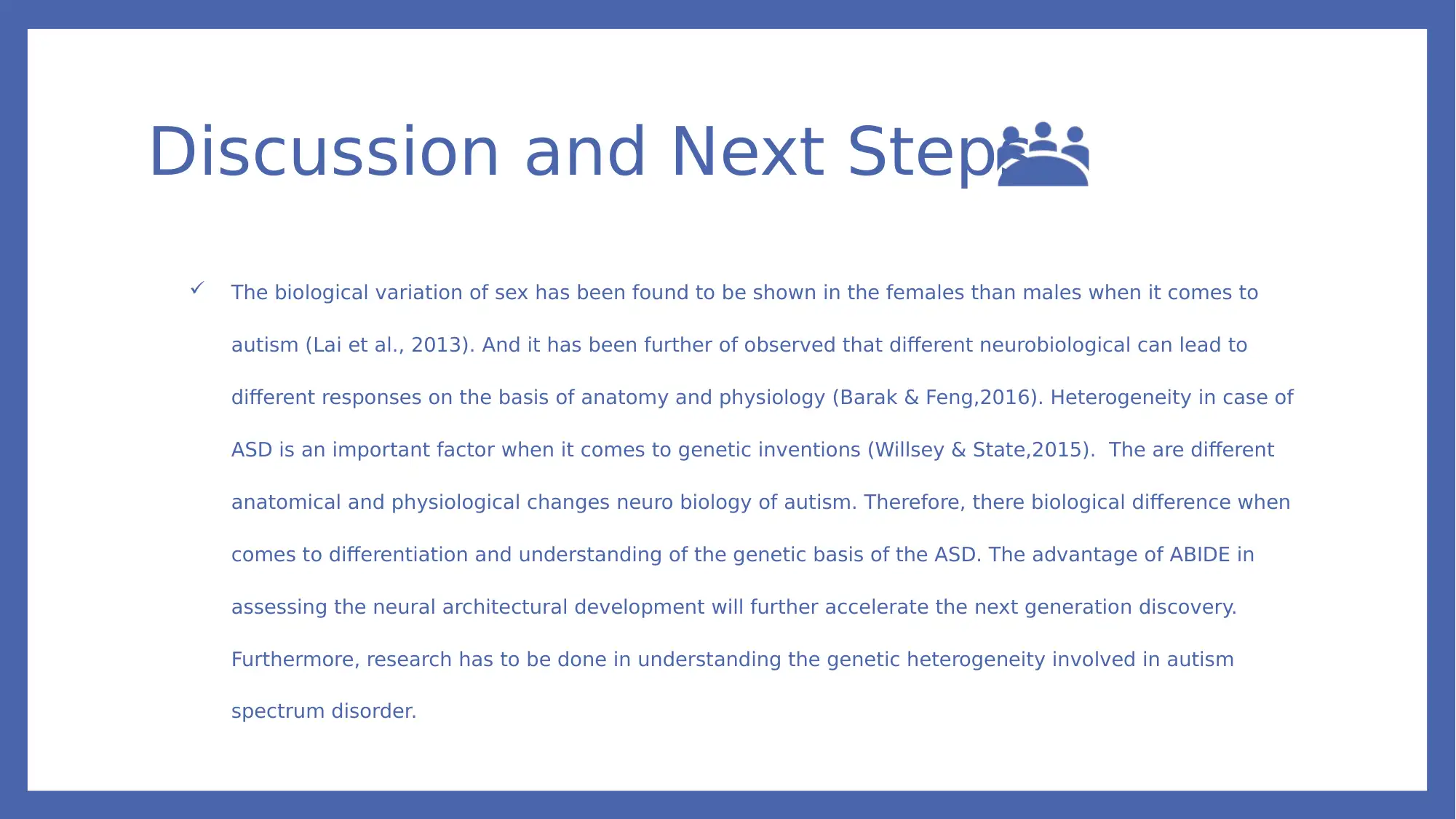
Discussion and Next Steps
The biological variation of sex has been found to be shown in the females than males when it comes to
autism (Lai et al., 2013). And it has been further of observed that different neurobiological can lead to
different responses on the basis of anatomy and physiology (Barak & Feng,2016). Heterogeneity in case of
ASD is an important factor when it comes to genetic inventions (Willsey & State,2015). The are different
anatomical and physiological changes neuro biology of autism. Therefore, there biological difference when
comes to differentiation and understanding of the genetic basis of the ASD. The advantage of ABIDE in
assessing the neural architectural development will further accelerate the next generation discovery.
Furthermore, research has to be done in understanding the genetic heterogeneity involved in autism
spectrum disorder.
The biological variation of sex has been found to be shown in the females than males when it comes to
autism (Lai et al., 2013). And it has been further of observed that different neurobiological can lead to
different responses on the basis of anatomy and physiology (Barak & Feng,2016). Heterogeneity in case of
ASD is an important factor when it comes to genetic inventions (Willsey & State,2015). The are different
anatomical and physiological changes neuro biology of autism. Therefore, there biological difference when
comes to differentiation and understanding of the genetic basis of the ASD. The advantage of ABIDE in
assessing the neural architectural development will further accelerate the next generation discovery.
Furthermore, research has to be done in understanding the genetic heterogeneity involved in autism
spectrum disorder.
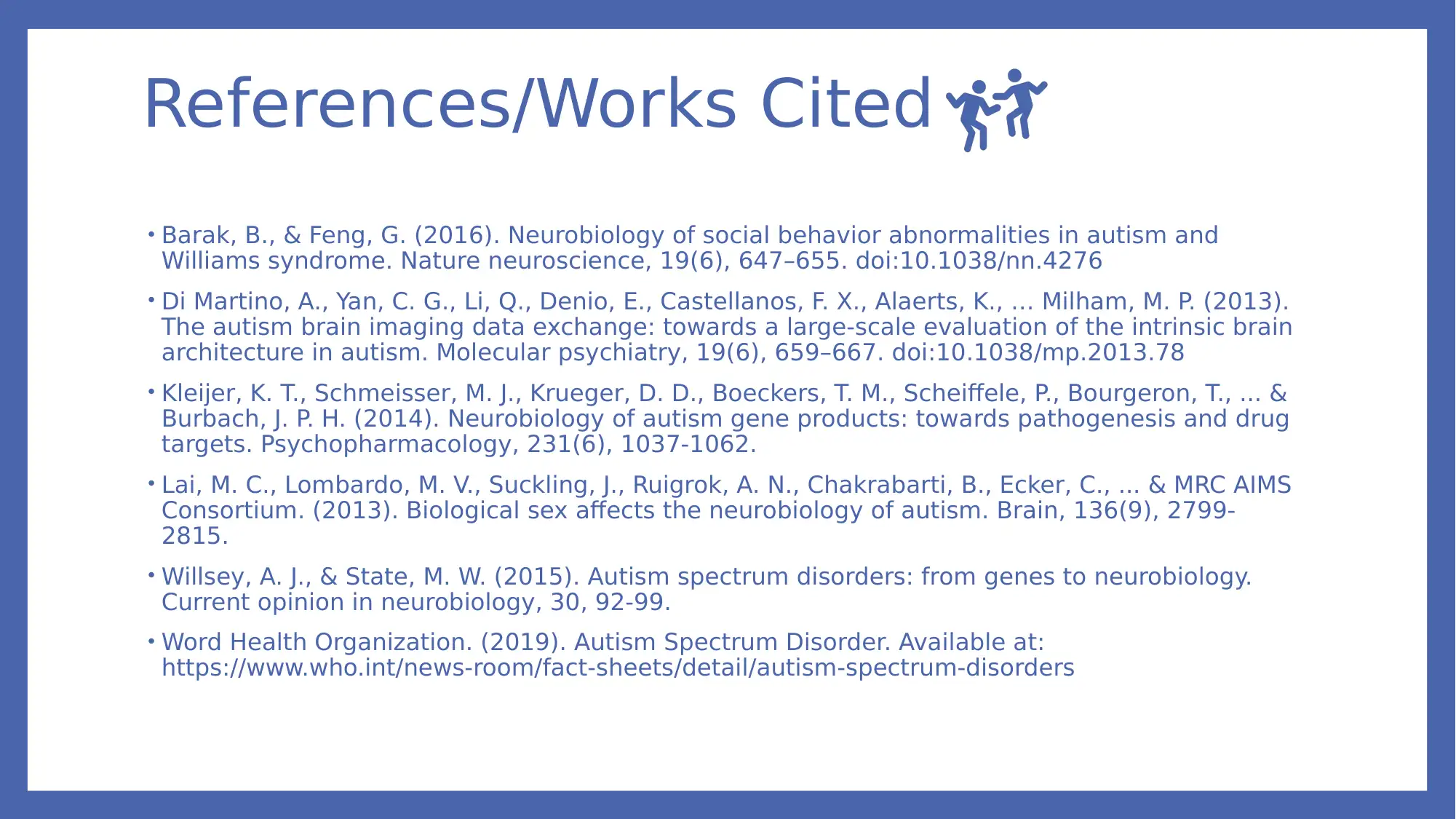
References/Works Cited
• Barak, B., & Feng, G. (2016). Neurobiology of social behavior abnormalities in autism and
Williams syndrome. Nature neuroscience, 19(6), 647–655. doi:10.1038/nn.4276
• Di Martino, A., Yan, C. G., Li, Q., Denio, E., Castellanos, F. X., Alaerts, K., … Milham, M. P. (2013).
The autism brain imaging data exchange: towards a large-scale evaluation of the intrinsic brain
architecture in autism. Molecular psychiatry, 19(6), 659–667. doi:10.1038/mp.2013.78
• Kleijer, K. T., Schmeisser, M. J., Krueger, D. D., Boeckers, T. M., Scheiffele, P., Bourgeron, T., ... &
Burbach, J. P. H. (2014). Neurobiology of autism gene products: towards pathogenesis and drug
targets. Psychopharmacology, 231(6), 1037-1062.
• Lai, M. C., Lombardo, M. V., Suckling, J., Ruigrok, A. N., Chakrabarti, B., Ecker, C., ... & MRC AIMS
Consortium. (2013). Biological sex affects the neurobiology of autism. Brain, 136(9), 2799-
2815.
• Willsey, A. J., & State, M. W. (2015). Autism spectrum disorders: from genes to neurobiology.
Current opinion in neurobiology, 30, 92-99.
• Word Health Organization. (2019). Autism Spectrum Disorder. Available at:
https://www.who.int/news-room/fact-sheets/detail/autism-spectrum-disorders
• Barak, B., & Feng, G. (2016). Neurobiology of social behavior abnormalities in autism and
Williams syndrome. Nature neuroscience, 19(6), 647–655. doi:10.1038/nn.4276
• Di Martino, A., Yan, C. G., Li, Q., Denio, E., Castellanos, F. X., Alaerts, K., … Milham, M. P. (2013).
The autism brain imaging data exchange: towards a large-scale evaluation of the intrinsic brain
architecture in autism. Molecular psychiatry, 19(6), 659–667. doi:10.1038/mp.2013.78
• Kleijer, K. T., Schmeisser, M. J., Krueger, D. D., Boeckers, T. M., Scheiffele, P., Bourgeron, T., ... &
Burbach, J. P. H. (2014). Neurobiology of autism gene products: towards pathogenesis and drug
targets. Psychopharmacology, 231(6), 1037-1062.
• Lai, M. C., Lombardo, M. V., Suckling, J., Ruigrok, A. N., Chakrabarti, B., Ecker, C., ... & MRC AIMS
Consortium. (2013). Biological sex affects the neurobiology of autism. Brain, 136(9), 2799-
2815.
• Willsey, A. J., & State, M. W. (2015). Autism spectrum disorders: from genes to neurobiology.
Current opinion in neurobiology, 30, 92-99.
• Word Health Organization. (2019). Autism Spectrum Disorder. Available at:
https://www.who.int/news-room/fact-sheets/detail/autism-spectrum-disorders
You're viewing a preview
Unlock full access by subscribing today!
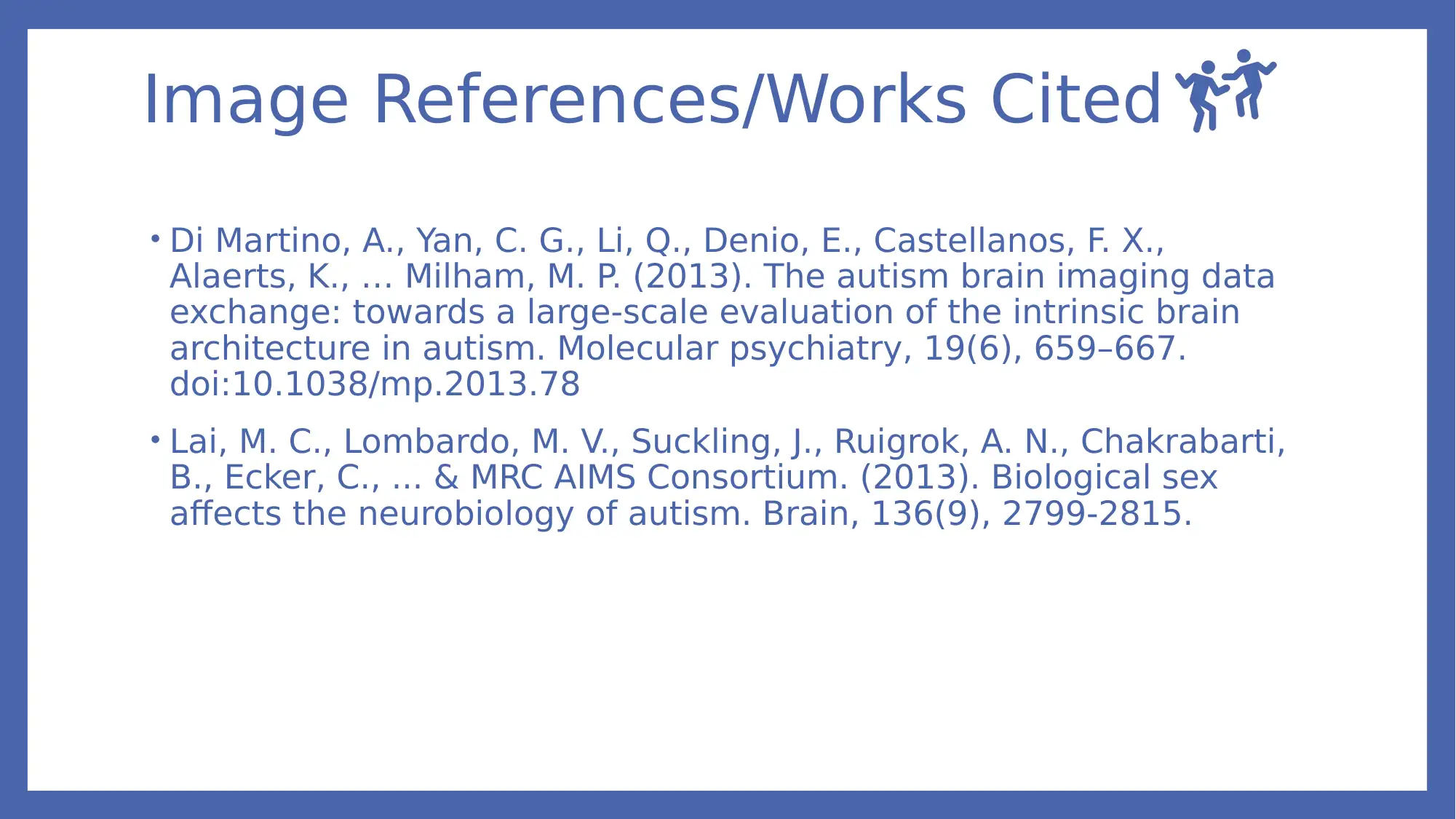
Image References/Works Cited
• Di Martino, A., Yan, C. G., Li, Q., Denio, E., Castellanos, F. X.,
Alaerts, K., … Milham, M. P. (2013). The autism brain imaging data
exchange: towards a large-scale evaluation of the intrinsic brain
architecture in autism. Molecular psychiatry, 19(6), 659–667.
doi:10.1038/mp.2013.78
• Lai, M. C., Lombardo, M. V., Suckling, J., Ruigrok, A. N., Chakrabarti,
B., Ecker, C., ... & MRC AIMS Consortium. (2013). Biological sex
affects the neurobiology of autism. Brain, 136(9), 2799-2815.
• Di Martino, A., Yan, C. G., Li, Q., Denio, E., Castellanos, F. X.,
Alaerts, K., … Milham, M. P. (2013). The autism brain imaging data
exchange: towards a large-scale evaluation of the intrinsic brain
architecture in autism. Molecular psychiatry, 19(6), 659–667.
doi:10.1038/mp.2013.78
• Lai, M. C., Lombardo, M. V., Suckling, J., Ruigrok, A. N., Chakrabarti,
B., Ecker, C., ... & MRC AIMS Consortium. (2013). Biological sex
affects the neurobiology of autism. Brain, 136(9), 2799-2815.
Paraphrase This Document
Need a fresh take? Get an instant paraphrase of this document with our AI Paraphraser

Thank you….
1 out of 17
Your All-in-One AI-Powered Toolkit for Academic Success.
+13062052269
info@desklib.com
Available 24*7 on WhatsApp / Email
![[object Object]](/_next/static/media/star-bottom.7253800d.svg)
Unlock your academic potential
© 2024 | Zucol Services PVT LTD | All rights reserved.